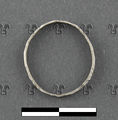AV-1 ring: Difference between revisions
Sindy Kluge (talk | contribs) No edit summary |
Sindy Kluge (talk | contribs) No edit summary |
||
| Line 16: | Line 16: | ||
|inventory_number=2001,37 | |inventory_number=2001,37 | ||
|source=Ziegaus & Rix 1998: 296–303, fig. 1,3; Neudert 2005: 9, fig. 4a, 4b; Ziegaus 2011: 644, fig. 7.18; Hauser 2011: 69–70 (cat. No. 2), pl. 1,2 | |source=Ziegaus & Rix 1998: 296–303, fig. 1,3; Neudert 2005: 9, fig. 4a, 4b; Ziegaus 2011: 644, fig. 7.18; Hauser 2011: 69–70 (cat. No. 2), pl. 1,2 | ||
|checklevel= | |checklevel=3 | ||
|problem=additional information | |||
}} | }} | ||
== Commentary == | == Commentary == | ||
Silver ring.<br>The ring is not completely round, but consists of numerous angular parts. Neither outside nor inside seams are visible. On the outside marks of hammer blows, on the inside traces of filing.<br> | Silver ring.<br>The ring is not completely round, but consists of numerous angular parts. Neither outside nor inside seams are visible. On the outside marks of hammer blows, on the inside traces of filing.<br> | ||
Outside a [[index::AV-1|circumferential inscription]].<br>The ring was discovered with other findings like a fibula or a coin by a private person at [[index::Flur Moosholz|Moosholz]] near to [[index::Nußdorf]]. In the immediate vicinity of the ring was also found the fibula which dates to the late [[index::Hallstatt period]], to the beginning of the 5th century BC. Consequently the ring could also date to the beginning of the 5th century BC, but it is not a constrained dating because silver objects of the [[index::Hallstatt period]] are very rare until now and other objects which date to the following period were also discovered at the find place. Moreover there are no parallel objects with regard to the form of the ring north of the Alps.<br>Predominantly the objects discovered at [[index::Flur Moosholz|Moosholz]] are fragmentary resp. demonstrate an intentional destruction. Therefore the find place could be interpreted as burnt offering site. | Outside a [[index::AV-1|circumferential inscription]].<br>The ring was discovered with other findings like a fibula or a coin by a private person at [[index::Flur Moosholz|Moosholz]] near to [[index::Nußdorf]]. In the immediate vicinity of the ring was also found the fibula which dates to the late [[index::Hallstatt period]], to the beginning of the 5th century BC. Consequently the ring could also date to the beginning of the 5th century BC, but it is not a constrained dating because silver objects of the [[index::Hallstatt period]] are very rare until now and other objects which date to the following period were also discovered at the find place. Moreover there are no parallel objects with regard to the form of the ring north of the Alps.<br>Predominantly the objects discovered at [[index::Flur Moosholz|Moosholz]] are fragmentary resp. demonstrate an intentional destruction. Therefore the find place could be interpreted as burnt offering site.<br>Autopsied by the ''Thesaurus Inscriptionum Raeticarum'' in May 2014.<br>''S.K.'' | ||
{{bibliography}} | {{bibliography}} | ||
Revision as of 17:34, 1 February 2015
| Object | |
|---|---|
| Classification: | ring |
| Material: | silver |
| Size: | diameter min. 1.8, diameter max. 2.2 cm, height 0.25 cm, weight 0.831 g |
| Condition: | complete |
| Archaeological culture: | Hallstatt D |
| Date: | 5th century BC |
| Date derived from: | archaeological context |
|
| |
| Site: | Nußdorf (Bayern, Germany) |
| Field name: | Flur Moosholz |
| Coordinates (approx.): | 47° 54' 21.60" N, 12° 35' 42.00" E [from site] |
| Find date: | 1995 |
| Find circumstances: | stray find |
| Current location: | Archäologische Staatssammlung München |
| Inventory Nr.: | 2001,37 |
|
| |
| Inscription: | AV-1 (tịp̣ṛuχ̣ṇụḷạṿịṣẹẓ§) |
|
| |
| Sources: | Ziegaus & Rix 1998: 296–303, fig. 1,3 Neudert 2005: 9, fig. 4a, 4b Ziegaus 2011: 644, fig. 7.18 Hauser 2011: 69–70 (cat. No. 2), pl. 1,2 |
Images
|
Object AV-1 ring - upper side.
|
Commentary
Silver ring.
The ring is not completely round, but consists of numerous angular parts. Neither outside nor inside seams are visible. On the outside marks of hammer blows, on the inside traces of filing.
Outside a circumferential inscription.
The ring was discovered with other findings like a fibula or a coin by a private person at Moosholz near to Nußdorf. In the immediate vicinity of the ring was also found the fibula which dates to the late Hallstatt period, to the beginning of the 5th century BC. Consequently the ring could also date to the beginning of the 5th century BC, but it is not a constrained dating because silver objects of the Hallstatt period are very rare until now and other objects which date to the following period were also discovered at the find place. Moreover there are no parallel objects with regard to the form of the ring north of the Alps.
Predominantly the objects discovered at Moosholz are fragmentary resp. demonstrate an intentional destruction. Therefore the find place could be interpreted as burnt offering site.
Autopsied by the Thesaurus Inscriptionum Raeticarum in May 2014.
S.K.
Bibliography
| Hauser 2011 | Florian Hauser, "Ein Opferplatz im Chiemgau?. Die hallstattzeitlichen Metallfunde von Nußdorf "Moosholz" (Lkr. Traunstein)", Bayerische Vorgeschichtsblätter Jahrgang 76 (2011), 55–142. |
|---|



